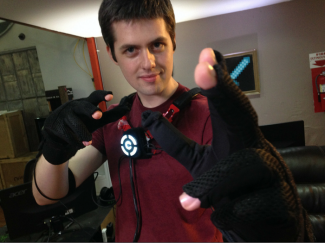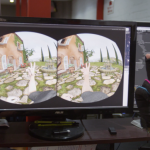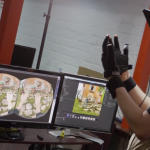If you’ve been following virtual reality news and opinion recently, you’ll have noticed a definite switch of focus for those seeking VR nirvana. Whilst there are myriad hard problems surrounding convincing your mind it occupies a virtual space, the visual element, provided by a VR headset display has now approached the point where presence is now possible. So, once you’ve solved the issue of presenting the virtual world to a player, what’s next on the list?
In one word, input. Whilst VR headset development has seen incredible progress since Oculus launched its Kickstarter, arguably a killer solution for reading a player’s actions has yet to reach the zenith. That’s not to say we haven’t seen progress, with companies like Sixense, YEI, Virtuix, Cyberith and Tactical Haptics all offering different ingenious solutions to the same problem and all seeing the light of day in the last 18 months. We’ve come a long way to be sure.
 Well now another solution has launched and it bears more resemblance to how you always imagined your VR gear to look. Control VR is a motion / gesture capture system comprising motion sensors and unique (at present in the consumer space at least) data gloves which track your upper body and finger movement at rotational accuracy, Control VR claim, down to the 10th of a degree.
Well now another solution has launched and it bears more resemblance to how you always imagined your VR gear to look. Control VR is a motion / gesture capture system comprising motion sensors and unique (at present in the consumer space at least) data gloves which track your upper body and finger movement at rotational accuracy, Control VR claim, down to the 10th of a degree.
Using IMU sensors the developers claim were developed in conjunction with DARPA (a claim we’ve yet to verify), sensors at your elbow joint and what looks to be an optical based tracker which sits at chest level attached to a small harness. The video shows demo equipment with mounted webcams, we assume to allow tracking of the player’s core.
The result is an incredibly cool looking way to reach into and intimately interact with the virtual world.
Technical details on the Kickstarter website are a little thin on the ground, but we dug a little deeper into Control VR’s origins.
The IGS Glove Becomes Control VR
Some of you may have seen a video circulating a few months ago demonstrating a great new data glove, being marketed squarely at the virtual reality enthusiast. The IGS Glove from a company called Synertial (aka Animazoo) seems to be the data glove component used in the Control VR system. The below video, from the company’s website, demonstrates in more detail the skeletal modelling used to achieve the impressive looking tracking.
..and in an earlier Control VR video, the IGS monicker is clearly seen on the player’s gloves:
What’s more, the listed CEO (Alex Sarnoff) and CTO (Ali Kord) for Control VR are both founders of Synertial / Animazoo. So it seems Control VR is a way for the company to enter the commercial VR market.
Synertial’s website has a slightly more technical description of the glove itself than available on the Kickstarter page:
Synertial’s systems use IMUs (Inertial Measurement Units) which make use of both tri-axial MEMS Gyroscopes and tri-axial MEMS Accelerometers in addition to magneto-resistive magnetometers. The combination of data from all three of these sensors overcomes the issues involved in traditional hand and finger capture.
An impressive array of IMUs, a reflection of how complex tracking the intricacies of the human hand really are. And, if the system is as impressive in person as it is in the extremely promising video demonstrations, we may have just edged even closer to that VR nirvana.
If you’re interested in backing the project, be warned that this cutting-edge tech doesn’t come cheap. The one arm and body tracking solution will set you back $350 and if you want both your hands in the game, the two arm tier is $600. My estimation though is that probably represents pretty good value for money considering the sheer number of sensors in involved here. The company does however point out that its commercial offerings (as detailed on their Kickstarter roadmap) will be much cheaper, and given the rapidly decreasing costs and rising accuracy of emerging IMU technology, we’re inclined to believe them.
Head over to the Kickstarter page here if you’re interested in backing the project. After only a few hours live, the project has already raised nearly $30k of its $250k goal. We’ll keep you in the loop on the campaigns progress.
Are you thinking of backing the project or have you already? Let us know your thoughts on the comments below.









